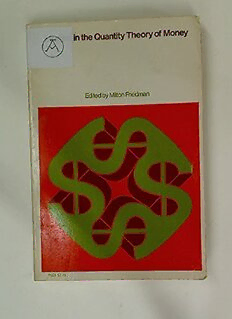
Studies in the Quantity Theory of Money PDF
Preview Studies in the Quantity Theory of Money
Studies in the Quantity Theory of Money Edited by Milton Friedman P561 $4.75 Studies in the Quantity Theory of Money This volume is a publication of the Workshop in Money and B"nking * ECONOMICS RESEARCH STUDIES of the ECONOMICS RESEARCH CENTER of the UNIVERSITY OF CHICAGO Studies in the of Quantity Theory Money Edited by MILTON FRIEDMAN With Essays by MILTON FRIEDMAN PHILLIP CAGAN JOHN J. KLEIN EUGENE M. LERNER RICHARD T. SELDEN THE UNIVERSITY OF CHICAGO PRESS CHICAGO & LONDON THE UNIVERSITY OF CHICAGO PRESS, CHICAGO 60637 The University of Chicago Press, Ltd., London © 1956 by The University of Chicago. All rights reserved Published 1956. Printed in the United States of America 81 80 79 78 77 1110987 .International Standard Book Number: 0-226-26404-1 (Clothbound) Library of Congress Catalog Number: 56-10999 Table of Contents I THE QUANTITY THEORY OF MONEY-A RESTATEMENT MILTON FRIEDMAN Page3 II THE MONETARY DYNAMICS OF HYPERINFLATION PHILLIP CAGAN Page 25 III GERMAN MONEY AND PRICES, 1932-44 JOHN J. KLEIN Page 121 IV INFLATION IN THE CONFEDERACY, 1861-65 EUGENE M. LERNER Page 163 v MONETARY VELOCITY IN THE UNITED STATES RICHARD T. SELDEN Page 179 INDEX Page 261 v I The Quantity Theory of Money-A Restatement MILTON FRIEDMAN The Quantity Theory of Money-A Restatement hE quantity theory of money is a term evocative of a general approach rather than a label for a well-defined theory. The exact content of the approach varies from a truism defining the term "velocity" to an allegedly rigid and unchanging ratio between the quantity of money-defined in one way or another-and the price level-also defined in one way or another. Whatever its precise meaning, it is clear that the general ap proach fell into disrepute after the crash of 1929 and the subsequent Great Depression and only recently has been slowly re-emerging into professional respectability. The present volume is partly a symptom of this re-emergence and partly a continuance of an aberrant tradition. Chicago was one of the few academic centers at which the quantity theory continued to be a central and vigorous part of the oral tradition throughout the 1930's and 1940's, where students continued to study monetary theory and to write theses on monetary problems. The quantity theory that retained this role dif fered sharply from the atrophied and rigid caricature that is so frequently described by the proponents of the new income-expenditure approach and with some justice, to judge by much of the literature on policy that was spawned by quantity theorists. At Chicago, Henry Simons and Lloyd Mints directly, Frank Knight and Jacob Viner at one remove, taught and developed a more subtle and relevant version, one in which the quantity theory was connected and integrated with general price theory and be came a flexible and sensitive tool for interpreting movements in aggregate economic activity and for developing relevant policy prescriptions. To the best of my knowledge, no systematic statement of this theory as developed at Chicago exists, though much can be read between the lines of Simons' and Mints's writings. And this is as it should be, for the Chicago tradition was not a rigid system, an unchangeable orthodoxy, but a way of looking at things. It was a theoretical approach that insisted that money does matter-that any interpretation of short-term movements in economic activity is likely to be seriously at fault if it neglects monetary changes and repercussions and if it leaves unexplained why people are willing to hold the particular nominal quantity of money in existence. The purpose of this introduction is not to enshrine-or, should I say, inter-a definitive version of the Chicago tradition. To suppose that one 3
